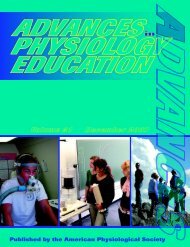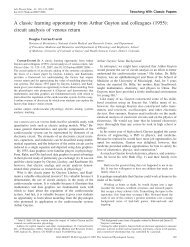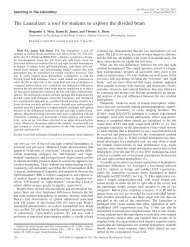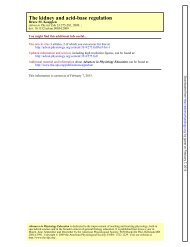construction of a model demonstrating neural pathways and reflex arcs
construction of a model demonstrating neural pathways and reflex arcs
construction of a model demonstrating neural pathways and reflex arcs
You also want an ePaper? Increase the reach of your titles
YUMPU automatically turns print PDFs into web optimized ePapers that Google loves.
INNOVATIONS A N D I D E A S<br />
neurobiology are too detailed <strong>and</strong> too expensive for<br />
the average high school science program. For ex-<br />
ample, although there are animated computer pro-<br />
grams detailing the basics <strong>of</strong> neuroscience, these<br />
programs are overly complex <strong>and</strong> too costly to be<br />
useful at the high school level (3). In contrast, our<br />
<strong>model</strong> was constructed with economical materials<br />
readily available through local electronics or hardware<br />
stores. l<br />
Our rationale for using a <strong>model</strong> was because “evi-<br />
dence suggests that, with the use <strong>of</strong> activity-based<br />
science programs, teachers can expect substantially<br />
improved performances in science processes” (1).<br />
Active participation with <strong>model</strong>s also reaches all types<br />
<strong>of</strong> learners in the visual, auditory, <strong>and</strong> kinesthetic <strong>and</strong><br />
tactile (VAK) scheme <strong>of</strong> learners. The V-type (visual)<br />
learners are targeted by the actual presence <strong>of</strong> the<br />
<strong>model</strong>, the supplied text, <strong>and</strong> instructions. A-type, or<br />
auditory, learners are reached through discussion<br />
during the laboratory exercise <strong>and</strong> teacher presenta-<br />
tion. K-type learners are satisfied through the building<br />
<strong>and</strong> manipulation <strong>of</strong> the <strong>model</strong>.<br />
Models also satisfy pedagogical principles for “h<strong>and</strong>s-<br />
on/minds-on” learning. This approach is supported by<br />
the theory <strong>of</strong> constructivism. Advocates <strong>of</strong> constructiv-<br />
ism point out that the importance <strong>of</strong> “h<strong>and</strong>s-on”<br />
science is that “students manipulate things physically<br />
. . .for a purpose <strong>and</strong> engage in discussion about it” (4).<br />
Our exercise not only provides an easy-to-build <strong>model</strong><br />
<strong>demonstrating</strong> <strong>neural</strong> <strong>pathways</strong> <strong>and</strong> <strong>reflex</strong> <strong>arcs</strong>, it also<br />
comes with supplemental teaching tools. In addition<br />
to detailed instructions concerning the <strong>construction</strong><br />
<strong>of</strong> the <strong>model</strong>, the supportive text contains discussion<br />
questions, photographs <strong>of</strong> the <strong>model</strong> under construc-<br />
tion, organizational concept maps, <strong>and</strong> instructive<br />
background information on the physiology related to<br />
the nervous system.<br />
Within the text are questions for the students to<br />
answer to help focus thinking <strong>and</strong> test comprehen-<br />
sion <strong>of</strong> the material, thus facilitating the learning<br />
1 Cost <strong>of</strong> the <strong>model</strong>s was based on purchasing all the<br />
supplies needed. Supplies were obtained at Radio Shack. The<br />
cost per one <strong>model</strong> came to an estimated $25.00.<br />
process. Questions are designed in a set, so that the<br />
first few questions in the set review comprehension <strong>of</strong><br />
the previous paragraphs. The last question in a set<br />
provokes thought on subsequent passages. At the end<br />
<strong>of</strong> the laboratory exercise are questions for discussion<br />
<strong>and</strong> integration <strong>of</strong> the entire learning experience.<br />
BACKGROUND TO NEUROBIOLOGY<br />
A concept map that organizes the basic concepts <strong>of</strong><br />
BACKGROUND TO NEUROBIOLOGY text material iS pre-<br />
sented in Fig. 1. This map presents the nervous<br />
system, with the components branching <strong>of</strong>f into<br />
smaller <strong>and</strong> smaller subunits. The text describing this<br />
map is presented in detail below.<br />
Questions are inserted within the text to help focus<br />
thinking <strong>and</strong> test comprehension <strong>of</strong> the material.<br />
Questions marked with arrows are comprehension<br />
questions to review previous passages. Questions<br />
marked with asterisks provoke thinking on subse-<br />
quent passages.<br />
Introduction<br />
Structurally, the nervous system is divided into the<br />
central nervous system (CNS) <strong>and</strong> the peripheral<br />
nervous system (PNS). The CNS consists <strong>of</strong> the<br />
brain <strong>and</strong> spinal cord. The PNS contains the spinal <strong>and</strong><br />
cranial nerves leading into <strong>and</strong> out <strong>of</strong> the CNS. There<br />
are 12 cranial nerves. All other nerves in the body are<br />
spinal nerves. Although the CNS <strong>and</strong> the PNS are<br />
separated into two “systems,” it is important to realize<br />
that they are connected to each other.<br />
The nervous system is constantly bombarded by<br />
stimuli, even during sleep. For example, as you read<br />
this, your nervous system is receiving different types<br />
<strong>of</strong> information gathered by your eyes, such as color,<br />
light, texture <strong>of</strong> the paper, <strong>and</strong> the words on the<br />
paper. This is known as sensory reception.<br />
VOLUME 16 : NUMBER 1 - ADVANCES IN PHYSIOLOGY EDUCATION - DECEMBER 1996<br />
s15









